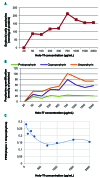Phlebotomy as an efficient long-term treatment of congenital erythropoietic porphyria
- PMID: 31919078
- PMCID: PMC7927993
- DOI: 10.3324/haematol.2019.228270
Phlebotomy as an efficient long-term treatment of congenital erythropoietic porphyria
Figures



References
-
- To-Figueras J, Ducamp S, Clayton J, et al. . ALAS2 acts as a modifier gene in patients with congenital erythropoietic porphyria. Blood. 2011;118(6):1443-1451. - PubMed
-
- Bhasker CR, Burgiel G, Neupert B, Emery-Goodman A, Kühn LC, May BK. The putative iron-responsive element in the human erythroid 5-aminolevulinate synthase mRNA mediates translational control. J Biol Chem. 1993;268(17):12699-705. - PubMed
-
- Katugampola RP, Anstey AV, Finlay AY, et al. . A management algorithm for congenital erythropoietic porphyria derived from a study of 29 cases. Br J Dermatol. 2012;167(4):888-900. - PubMed

